Rational Design of Cellulose Nanofibrils Separator for Sodium-Ion Batteries
Abstract
:1. Introduction
2. Results and Discussion
2.1. Morphology and Structure of TOCNF Separators
2.2. Electrolyte Wettability of TOCNF Separator
2.3. Electrochemical Performances of TOCNF Separators
2.4. Mechanical Performances of TOCNF Separators
2.5. Comparison with Other Separators for SIB
3. Experimental Section
3.1. Materials
3.2. Preparation of Cellulose Nanofibrils
3.3. Preparation of the TOCNF Separator
3.4. Characterization of TOCNF Separator
3.5. Electrochemical Measurements
4. Conclusions
Author Contributions
Funding
Institutional Review Board Statement
Informed Consent Statement
Data Availability Statement
Acknowledgments
Conflicts of Interest
Sample Availability
References
- López, F.; Perez, A.; García, J.; Feria, M.; Garcia, M.; Fernández, M. Cellulosic pulp from Leucaena diversifolia by soda–ethanol pulping process. Chem. Eng. J. 2011, 166, 22–29. [Google Scholar] [CrossRef]
- Si, X.; Lu, F.; Chen, J.; Lu, R.; Huang, Q.; Jiang, H.; Taarning, E.; Xu, J. A strategy for generating high-quality cellulose and lignin simultaneously from woody biomass. Green Chem. 2017, 19, 4849–4857. [Google Scholar] [CrossRef]
- He, J.; Bian, K.; Piao, G. Self-assembly properties of carboxylated tunicate cellulose nanocrystals prepared by ammonium persulfate oxidation and subsequent ultrasonication. Carbohydr. Polym. 2020, 249, 116835. [Google Scholar] [CrossRef]
- Mitov, M. Cholesteric Liquid Crystals with a Broad Light Reflection Band. Adv. Mater. 2012, 24, 6260–6276. [Google Scholar] [CrossRef]
- Gao, H.; Duan, B.; Lu, A.; Deng, H.; Du, Y.; Shi, X.; Zhang, L. Fabrication of cellulose nanofibers from waste brown algae and their potential application as milk thickeners. Food Hydrocoll. 2018, 79, 473–481. [Google Scholar] [CrossRef]
- Chen, C.; Hu, L. Nanocellulose toward Advanced Energy Storage Devices: Structure and Electrochemistry. Acc. Chem. Res. 2018, 51, 3154–3165. [Google Scholar] [CrossRef]
- Kim, H.; Mattinen, U.; Guccini, V.; Liu, H.; Salazar-Alvarez, G.; Lindström, R.W.; Lindbergh, G.; Cornell, A. Feasibility of chemically modified cellulose nanofiber membranes as lithium-ion battery separators. ACS Appl. Mater. Interfaces 2020, 12, 41211–41222. [Google Scholar] [CrossRef]
- Gwon, H.; Park, K.; Chung, S.-C.; Kim, R.-H.; Kang, J.K.; Ji, S.M.; Kim, N.-J.; Lee, S.; Ku, J.-H.; Do, E.C.; et al. A safe and sustainable bacterial cellulose nanofiber separator for lithium rechargeable batteries. PNAS Proc. Natl. Acad. Sci. USA 2019, 116, 19288–19293. [Google Scholar] [CrossRef] [Green Version]
- Liu, J.; Yang, K.; Mo, Y.; Wang, S.; Han, D.; Xiao, M.; Meng, Y. Highly safe lithium-ion batteries: High strength separator from polyformaldehyde/cellulose nanofibers blend. J. Power Sources 2018, 400, 502–510. [Google Scholar] [CrossRef]
- Hwang, J.-Y.; Myung, S.-T.; Sun, Y.-K. Sodium-ion batteries: Present and future. Chem. Soc. Rev. 2017, 46, 3529–3614. [Google Scholar] [CrossRef] [Green Version]
- Jamesh, M.I.; Prakash, A. Advancement of technology towards developing Na-ion batteries. J. Power Sources 2018, 378, 268–300. [Google Scholar] [CrossRef]
- Casas, X.; Niederberger, M.; Lizundia, E. A sodium-ion battery separator with reversible voltage response based on water-soluble cellulose derivatives. ACS Appl. Mater. Interfaces 2020, 12, 29264–29274. [Google Scholar] [CrossRef]
- Zhu, T.; Zuo, X.; Li, Y.; Zhang, L.; Xie, D.; Xiao, X.; Liu, J.; Nan, J. A novel membrane based on cellulose acetate nanofibers with a ZrO2 reinforcement layer for advanced sodium-ion batteries. J. Membr. Sci. 2021, 620, 118917. [Google Scholar] [CrossRef]
- Lv, D.; Chai, J.; Wang, P.; Zhu, L.; Liu, C.; Nie, S.; Li, B.; Cui, G. Pure cellulose lithium-ion battery separator with tunable pore size and improved working stability by cellulose nanofibrils. Carbohydr. Polym. 2021, 251, 116975. [Google Scholar] [CrossRef]
- Li, J.; Song, T.; Xiu, H.; Zhang, M.; Cheng, R.; Liu, Q.; Zhang, X.; Kozliak, E.; Ji, Y. Foam materials with controllable pore structure prepared from nanofibrillated cellulose with addition of alcohols. Ind. Crops Prod. 2018, 125, 314–322. [Google Scholar] [CrossRef]
- Chun, S.-J.; Choi, E.-S.; Lee, E.-H.; Kim, J.H.; Lee, S.-Y.; Lee, S.-Y. Eco-friendly cellulose nanofiber paper-derived separator membranes featuring tunable nanoporous network channels for lithium-ion batteries. J. Mater. Chem. 2012, 22, 16618–16626. [Google Scholar] [CrossRef]
- Jiang, F.; Hsieh, Y.-L. Self-assembling of TEMPO Oxidized Cellulose Nanofibrils As Affected by Protonation of Surface Carboxyls and Drying Methods. ACS Sustain. Chem. Eng. 2015, 4, 1041–1049. [Google Scholar] [CrossRef]
- Hao, Y.; Wang, C. Free-standing reduced graphene oxide/carbon nanotube paper for flexible sodium-ion battery applications. Molecules 2020, 25, 1014. [Google Scholar] [CrossRef] [PubMed] [Green Version]
- Lin, X.; Du, X.; Tsui, P.S.; Huang, J.-Q.; Tan, H.; Zhang, B. Exploring room- and low-temperature performance of hard carbon material in half and full Na-ion batteries. Electrochim. Acta 2019, 316, 60–68. [Google Scholar] [CrossRef]
- Park, S.-W.; Ha, J.H.; Park, J.M.; Cho, B.W.; Choi, H.-J. Enhanced capacity retention based silicon nanosheets electrode by CMC coating for lithium-ion batteries. Electron. Mater. Lett. 2021, 17, 268–276. [Google Scholar] [CrossRef]
- Zhang, C.; Jiang, Q.; Liu, A.; Wu, K.; Yang, Y.; Lu, J.; Cheng, Y.; Wang, H. The bead-like Li3V2(PO4)3/NC nanofibers based on the nanocellulose from waste reed for long-life Li-ion batteries. Carbohydr. Polym. 2020, 237, 116134. [Google Scholar] [CrossRef]
- Ojanguren, A.; Mittal, N.; Lizundia, E.; Niederberger, M. Stable Na Electrodeposition Enabled by Agarose-Based Water-Soluble Sodium Ion Battery Separators. ACS Appl. Mater. Interfaces 2021, 13, 21250–21260. [Google Scholar] [CrossRef]
- Woo, S.-G.; Hwang, E.-K.; Kang, H.-K.; Lee, H.; Lee, J.-N.; Kim, H.-S.; Jeong, G.; Yoo, D.-J.; Lee, J.; Kim, S.; et al. High transference number enabled by sulfated zirconia superacid for lithium metal batteries with carbonate electrolytes. Energy Environ. Sci. 2021, 14, 1420–1428. [Google Scholar] [CrossRef]
- Yang, Y.; Chang, Z.; Li, M.; Wang, X.; Wu, Y. A sodium ion conducting gel polymer electrolyte. Solid State Ion. 2015, 269, 1–7. [Google Scholar] [CrossRef]
- Dyartanti, E.R.; Sunaryati, N.; Alhakim, R.R.; Putri, L.N.; Putri, A.Y.M.; Nurohmah, A.R.; Nisa, S.S. Recent Development of Polyvinylidene Fluoride/Cellulose Membranes Electrolyte Separator for Lithium Ion Batteries. IOP Conf. Ser. Mater. Sci. Eng. 2021, 1096, 012144. [Google Scholar] [CrossRef]
- Arunkumar, R.; Saroja, A.P.V.K.; Sundara, R. Barium titanate-based porous ceramic flexible membrane as a separator for room-temperature sodium-ion battery. ACS Appl. Mater. Interfaces 2019, 11, 3889–3896. [Google Scholar] [CrossRef]
- Zhu, Y.; Yang, Y.; Fu, L.; Wu, Y. A porous gel-type composite membrane reinforced by nonwoven: Promising polymer electrolyte with high performance for sodium ion batteries. Electrochim. Acta 2017, 224, 405–411. [Google Scholar] [CrossRef] [Green Version]
- Janakiraman, S.; Surendran, A.; Ghosh, S.; Anandhan, S.; Venimadhav, A. Electroactive poly(vinylidene fluoride) fluoride separator for sodium ion battery with high coulombic efficiency. Solid State Ion. 2016, 292, 130–135. [Google Scholar] [CrossRef]
- Jo, J.H.; Jo, C.-H.; Qiu, Z.; Yashiro, H.; Shi, L.; Wang, Z.; Yuan, S.; Myung, S.-T. Nature-derived cellulose-based composite separator for sodium-ion batteries. Front. Chem. 2020, 8, 153. [Google Scholar] [CrossRef] [PubMed]
- Gu, J.; Hsieh, Y.-L. Surface and structure characteristics, self-assembling, and solvent compatibility of holocellulose nano-fibrils. ACS Appl. Mater. Interfaces 2015, 7, 4192–4201. [Google Scholar] [CrossRef] [Green Version]
- Kim, H.; Guccini, V.; Lu, H.; Salazar-Alvarez, G.; Lindbergh, G.; Cornell, A. Lithium ion battery separators based on car-boxylated cellulose nanofibers from wood. ACS Appl. Energy Mater. 2019, 2, 1241–1250. [Google Scholar] [CrossRef]
- Islam, A.; Ong, H.L.; Villagracia, A.R.; Halim, K.A.A.; Ganganboina, A.B.; Doong, R.-A. Biomass–derived cellulose nanofibrils membrane from rice straw as sustainable separator for high performance supercapacitor. Ind. Crops Prod. 2021, 170, 113694. [Google Scholar] [CrossRef]
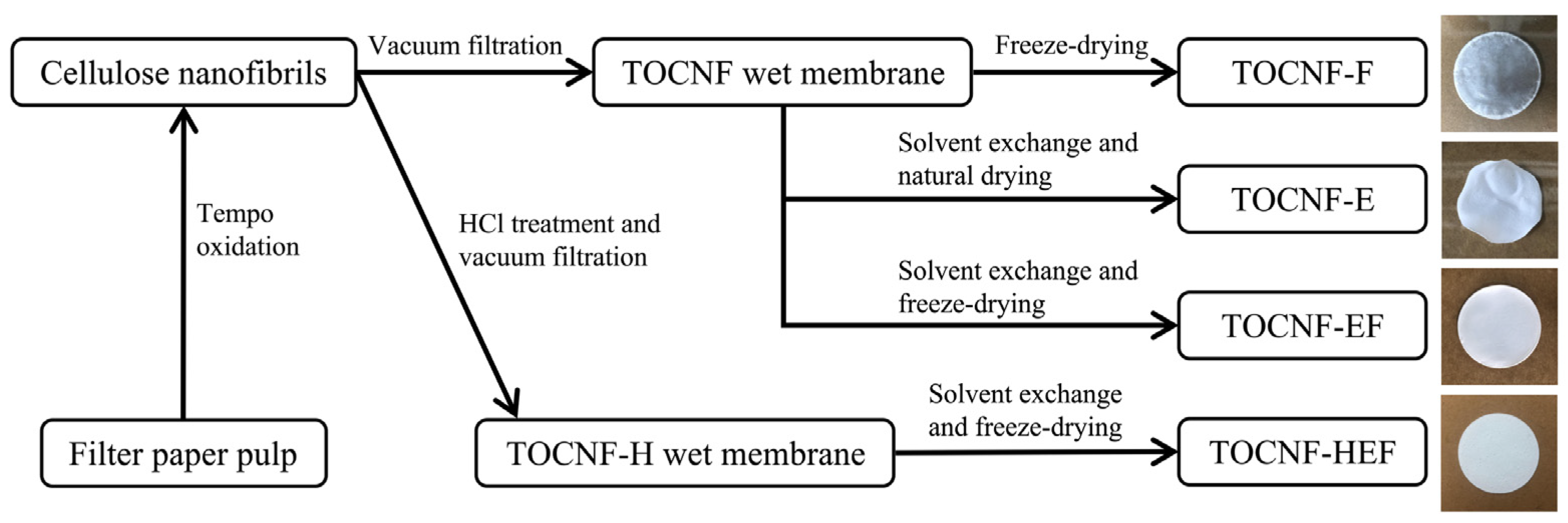

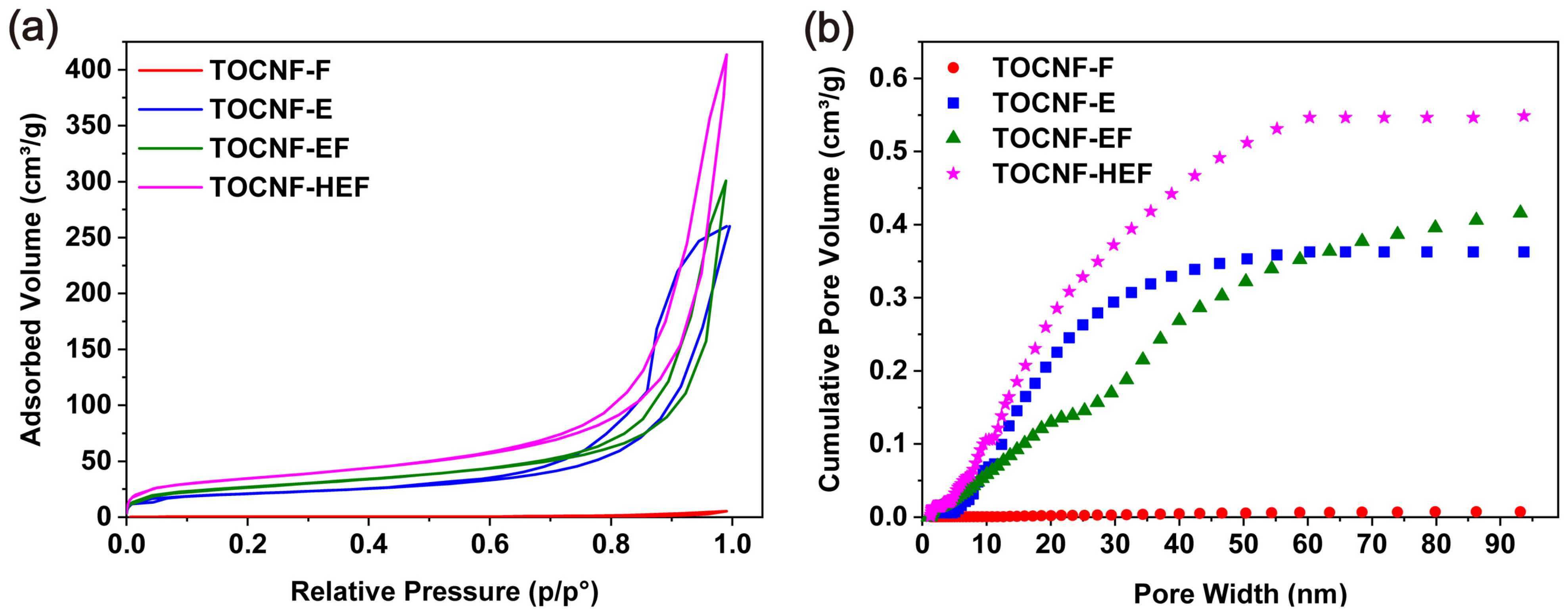
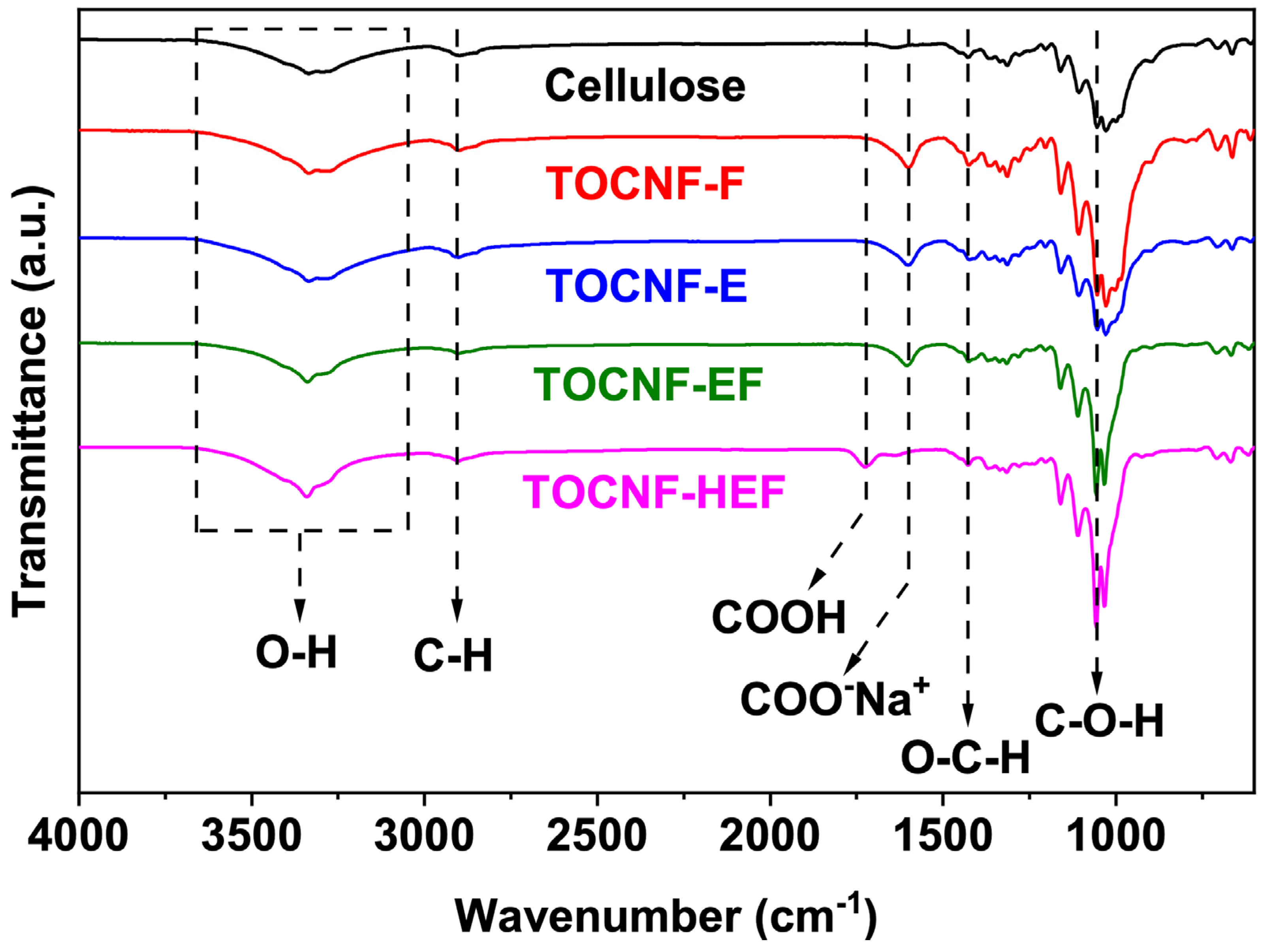

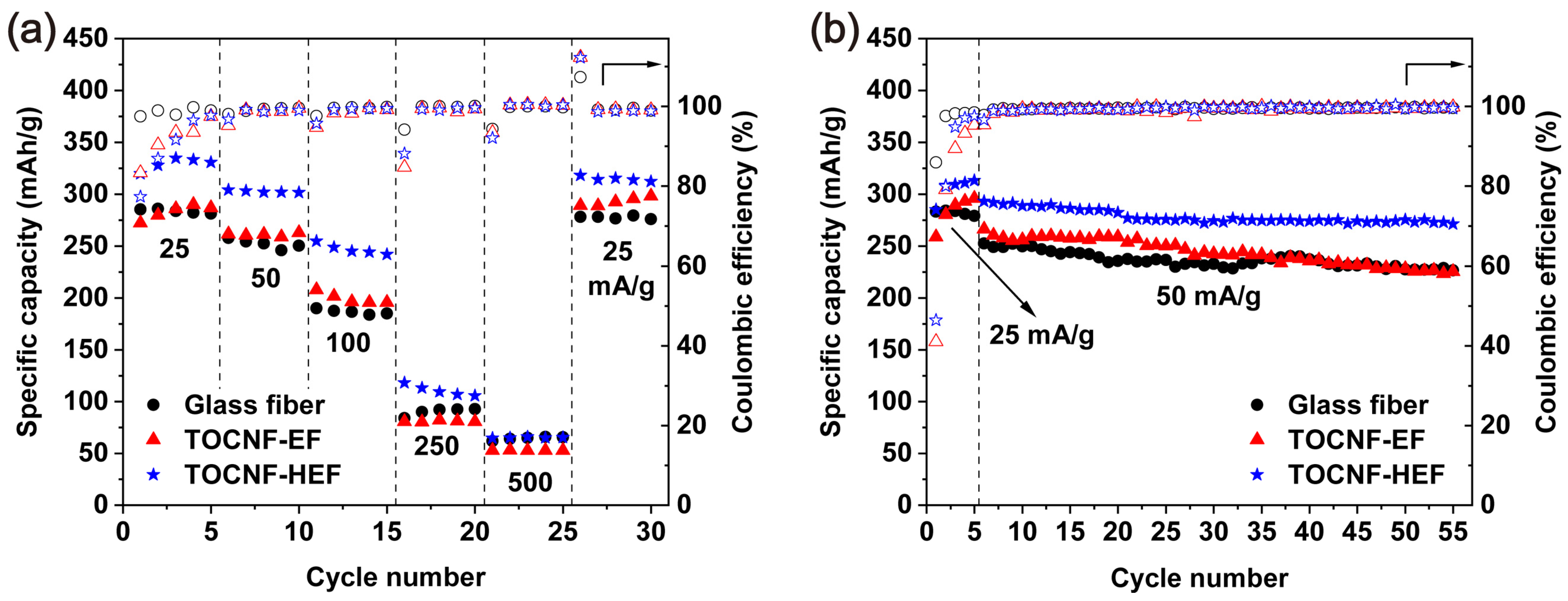
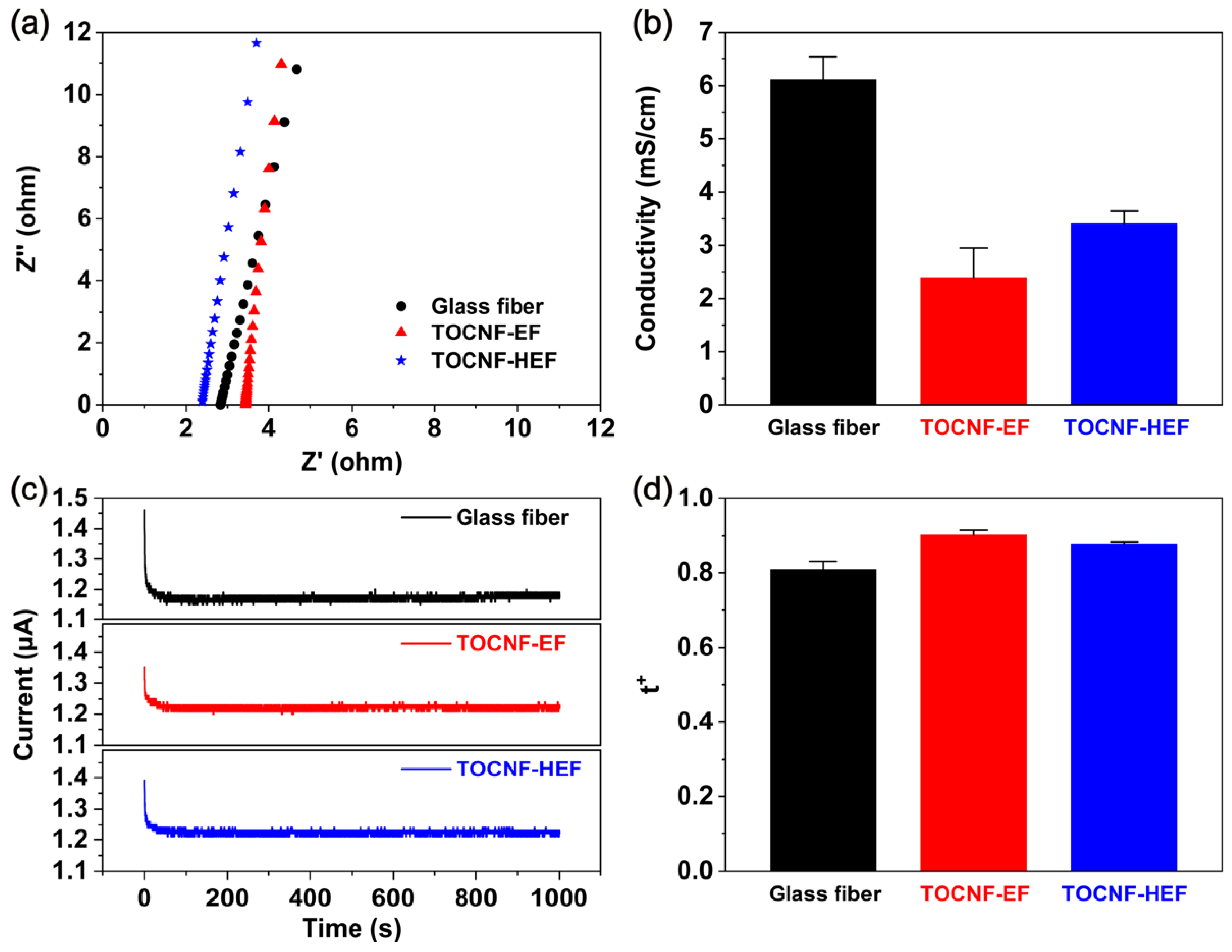

| Parameter | TOCNF-F | TOCNF-E | TOCNF-EF | TOCNF-HEF |
|---|---|---|---|---|
| Thickness (μm) | 80 | 150 | 240 | 250 |
| Porosity (%) | 37.1 | 57.1 | 70.8 | 74.6 |
| Uptake (%) | 206.2 | 547.7 | 776.7 | 978.8 |
| Contact angle | 64.7 | 17.8 | 12.5 | 0 |
| Separator | Ionic Conductivity (mS/cm) | Na+ Transference Number | Tensile Strength (MPa) | Electrolyte Uptake (wt%) | Reference |
|---|---|---|---|---|---|
| TOCNF-HEF | 3.41 | 0.88 | 4.49 | >800 | This work |
| Glass fiber | 6.11 | 0.80 | 0.18 | >800 | This work |
| Porous Ceramic | 8.11 | 0.80 | 0.9 | 175 | [26] |
| Celgard 2730 | 0.16 | 0.17 | 35.3 | 50 | [27] |
| PVDF | 0.74 | - | - | 341 | [28] |
| CMC/HEC | 3.83 | - | - | 131.4 | [12] |
| ZrO2@MCA | 2.23 | - | 1.15 | 409.2 | [13] |
| Agarose/PVA | 1.21 | - | 10.4 | 302.7 | [22] |
| Cellulose-PAN-Al2O3 | 0.75 | 0.78 | - | 286 | [29] |
Publisher’s Note: MDPI stays neutral with regard to jurisdictional claims in published maps and institutional affiliations. |
© 2021 by the authors. Licensee MDPI, Basel, Switzerland. This article is an open access article distributed under the terms and conditions of the Creative Commons Attribution (CC BY) license (https://creativecommons.org/licenses/by/4.0/).
Share and Cite
Zhou, H.; Gu, J.; Zhang, W.; Hu, C.; Lin, X. Rational Design of Cellulose Nanofibrils Separator for Sodium-Ion Batteries. Molecules 2021, 26, 5539. https://doi.org/10.3390/molecules26185539
Zhou H, Gu J, Zhang W, Hu C, Lin X. Rational Design of Cellulose Nanofibrils Separator for Sodium-Ion Batteries. Molecules. 2021; 26(18):5539. https://doi.org/10.3390/molecules26185539
Chicago/Turabian StyleZhou, Hongyang, Jin Gu, Weiwei Zhang, Chuanshuang Hu, and Xiuyi Lin. 2021. "Rational Design of Cellulose Nanofibrils Separator for Sodium-Ion Batteries" Molecules 26, no. 18: 5539. https://doi.org/10.3390/molecules26185539






